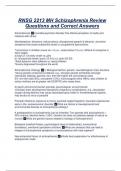RNSG 2213 MH Schizophrenia Review
Questions and Correct Answers
Schizophrenia ✅incurable psychotic disorder that affects perception of reality and
relations with others
Manifestations: delusions, hallucinations, disorganized speech & behavior, and other
symptoms that cause substantial social or occupational dysfunctions
*Uncommon in children (never dx < 5 y.o., rarely before 15 y.o.); difficult to recognize in
early stages
a) boys 2:1 at early onset vs. girls
b) 1st psychotic break: boys (15-24 y.o.); girls (20-29)
*Adult behavior often different vs. teens/children
*Evenly diagnosed throughout the world
Schizophrenia: Etiology ✅1) Biological factors: genetic, neurobiological, brain structure
*strong genetic component evidence: e.g., stronger genetic similarities amongst
individuals (siblings, parents, etc), then the higher the concordance rates
EX: non-twin sibs (9%), one parent (13%), mononzygotic twins (48%); also children of
schizo mothers are at greater risk DESPITE who raises them
2) psych and environmental: prenatal, psychological, environmental
*prenatal: brain development disruptions; pregnancy complications, e.g., decreased
oxygen during delivery may cause decreased gray matter in frontal/temporal regions;
may be due to virus or parasite
Prenatal infections, exposure to toxins, parental neglect/rejection; traumatic experiences
early in life, socioeconomic diversity ✅What are factors in developmental and
environmental theories of schizophrenia etiology?
A predisposition to schizophrenia can be inherited. Two parents with schizophrenia =
35% chance; identical twins = 50%. Genetic risk does not address debate of nature vs
nurture ✅What are genetic factors related to etiology of Schizophrenia?
Biological (medical illness), psychological (loss of relationship), sociocultural
(homeless), emotional (persistent criticism) ✅What are stressors that can lead to
relapse of schizophrenia symptoms or noncompliance with med regimen?
Neurochemical theory of schizophrenia ✅affords best explanation for effectiveness of
antipsychotic meds:
,1) increased levels of dopamine in limbic area of the brain lead to schizophrenia and
psychotic symptoms. *Dopamine blocking activity of antipsychotics allows for
effectiveness in treatment.
2) SEROTONIN might play a role
*2nd generation ABX block DA and serotonin
Dopamine Theory of Schizo ✅brain injury to prefontal cortex leads to:
1) DA underactive in prefontal cortex = NEG symptoms
2) release of mesolimbic DA neurons from inhibitory control = POS symptoms
*BUT not complete theory: other transmitters (serotonin, GABA, glutamate) involved;
Schizo: diathesis-stress model ✅scientific consensus on this etiology that occurs
when:
1) multiple inherited genes combine with other factors, e.g., viruses, birth injuries,
environmental stressors, prenatal nutrition, that alter brain structure and
neurotransmitter systems
Pathoanatomy changes as indicated in neurostructural theories of the etiology of
schizophrenia? ✅1) Enlarged ventricles (ventricular brain ratios; implies loss of brain
cells),
2) brain atrophy,
3) decreased cortical blood flow and low metabolic rates—esp in prefrontal cortex:
many schizo behaviors (speech, decision-making) governed by prefontal
glucose metabolism in frontal/temporal lobes; in basal ganglia. Abnormal wave patterns
indicating absence of ability to calm the brain.
Schizo: Diagnostic Imaging ✅1) Structure: CT, MRI
2) Function: PET, SPECT, fMRI
Scans can show: enlarged ventricles, decreased brain volume, decreased blood flow to
frontal lobes, reduced gray matter
Schizo: DSM5 ✅2 out of 5 symptoms for one month:
a) delusions
b) hallucinations
c) disorganized speech
d) disorganized or catatonic behavior
e) negative symptoms
OR 1 symptom (a, b or c)
Positive symptoms of schizophrenia ✅arise from too much dopamine in the limbic area
(hyperactive mesolimbic tract):
1) abnormal thoughts,
, 2) agitation,
3) bizarre behavior,
4) delusions,feelings of persecution, grandiosity,
5) hallucinations,
6) hostility,
7) illusions,
8) insomnia,
9) PARANOIA; suspiciousness. (during this phase may have hallucinations, delusions)
*Antipsychotic agents effective in treatment.
Positive Symptoms: Thought alterations ✅1) delusions: false, fixed beliefs
2) concrete thinking: inability to think abstractly
3) magical thinking
4) paranoia
5) religiosity
6) tangentiality
7) circumstantiality
8) cognitive retardation
Positive Symptoms: Speech alterations ✅associative "looseness"
1) clang associations
2) word salad
3) neologisms
4) echolalia (echo-like: immediate, involuntary repetition of words spoken by another)
Positive Symptoms: Perception alterations ✅1) depersonalization
2) derealization
3) hallucinations: auditory, command, visual
Positive Symptoms: Behavior ✅1) MOTOR: catatonia, motor retardation, motor
agitation, gesturing, posturing, waxy flexibility
2) echopraxia: imitating actions of others
3) impaired impulse control
4) negativism
5) boundary impairment
6) stereotyped behaviors
Schizophrenia: Negative Symptoms ✅symptoms are essentially an
absence/dimunition of that which should be—lack of affect, lack of energy, etc.
R/t hypodopaminergic process. Decreased cerebral blood flow, increased ventricular
brain ratios.
Antipsychotics typically have less effect, may cause symptoms to worsen.
Negative symptoms of schizophrenia ✅arise from too little dopamine in the cortex
(hypoactive mesocortical tract);




